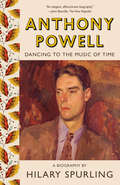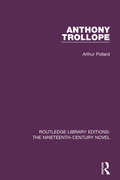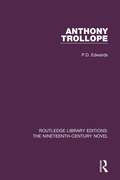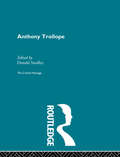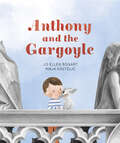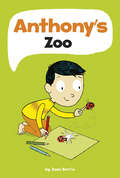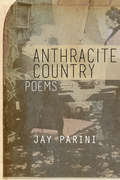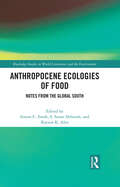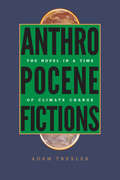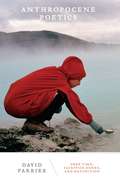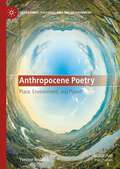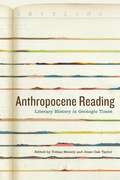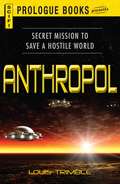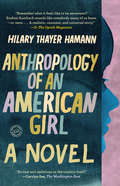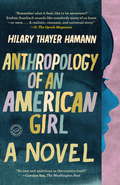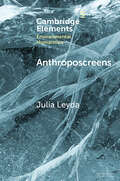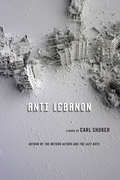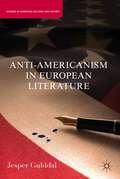- Table View
- List View
Anthony Munday and the Catholics, 1560–1633
by Donna B. HamiltonIn this new study, Donna B. Hamilton offers a major revisionist reading of the works of Anthony Munday, one of the most prolific authors of his time, who wrote and translated in many genres, including polemical religious and political tracts, poetry, chivalric romances, history of Britain, history of London, drama, and city entertainments. Long dismissed as a hack who wrote only for money, Munday is here restored to his rightful position as an historical figure at the centre of many important political and cultural events in sixteenth- and seventeenth-century England. In Anthony Munday and the Catholics, 1560-1633, Hamilton reinterprets Munday as a writer who began his career writing on behalf of the Catholic cause and subsequently negotiated for several decades the difficult terrain of an ever-changing Catholic-Protestant cultural, religious, and political landscape. She argues that throughout his life and writing career Munday retained his Catholic sensibility and occasionally wrote dangerously on behalf of Catholics. Thus he serves as an excellent case study through which present-day scholars can come to a fuller understanding of how a person living in this turbulent time in English history - eschewing open resistance, exile or martyrdom - managed a long and prolific writing career at the centre of court, theatre, and city activities but in ways that reveal his commitment to Catholic political and religious ideology. Individual chapters in this book cover Munday's early writing, 1577-80; his writing about the trial and execution of Jesuit Edmund Campion; his writing for the stage, 1590-1602; his politically inflected translations of chivalric romance; and his writings for and about the city of London, 1604-33. Hamilton revisits and revalues the narratives told by earlier scholars about hack writers, the anti-theatrical tracts, the role of the Earl of Oxford as patron, the political-religious interests of Munday's plays, the implications of Mu
Anthony Powell: Dancing to the Music of Time
by Hilary SpurlingThe author of the award-winning, two-volume Matisse: A Life, now gives us the long-awaited, definitive biography of literary master Anthony Powell--the critic, editor, and novelist known as "the English Proust"-- that, at the same time, takes us deep into twentieth-century London literary life.Anthony Powell (1905-2000), best known for his twelve-volume comic masterpiece, A Dance to the Music of Time, was also the author of sixteen earlier novels, plays, and biographies, five memoirs, and three volumes of journals. He was a prolific literary critic and book reviewer. Between the two world wars, before making his name, he kept company with rowdy, hard-up writers and painters--and painters' models--in the London where Augustus John and Wyndham Lewis loomed large. He counted Evelyn Waugh and Henry Green among his lifelong friends, and his circle included the Sitwells, Graham Greene, George Orwell, Philip Larkin, and Kingsley Amis, among many others. Now, drawing on his letters, diaries, and interviews, Hilary Spurling--herself a longtime friend of Powell's-- has written a fresh and masterful portrait of the man, his work, and his time. Insightful, poignant, and cinematic in scope, this biography is as much a brilliant tapestry of a seminal moment in London's literary life as it is a revelation of an iconic literary figure.
Anthony Trollope (Routledge Library Editions: The Nineteenth-Century Novel #32)
by Arthur PollardAnthony Trollope is perhaps best known for the group of Barsetshire novels, a rich and enduring picture of society in a small cathedral town. He also wrote a number of Irish novels and a series about political society known as the ‘Palliser novels’. First published in 1978, this introduction to Trollope’s life and work surveys all of his forty-seven novels, as well as his various miscellaneous works, and calls for a reassessment of his impressive achievement. This book will be of interest to those studying Victorian literature.
Anthony Trollope: His Art And Scope (Routledge Library Editions: The Nineteenth-Century Novel #12)
by P.D. EdwardsFirst published in 1968, this book sets out to refute the idea of Trollope as a ‘mild cathedral-town novelist, describing storms in ecclesiastical tea cups’ which prevailed at the time in spite of his stature during his lifetime. The author reveals the full strength and range of Trollope’s achievement and provides an excellent introduction to further exploration of the novels. Two sections — ‘Narrative Method’ and ‘Subject-Matter’ — are used as the basis from which the author examines key themes in Trollope’s work, with instructive extracts from the novels included to illustrate these points and upon which commentary is provided. This book will be of interest to students of literature.
Anthony Trollope: The Critical Heritage (Critical Heritage Ser.)
by Donald SmalleyFirst Published in 1995. Routledge is an imprint of Taylor & Francis, an informa company.
Anthony and the Gargoyle
by Jo Ellen BogartA boy befriends a baby gargoyle in this magical wordless story in graphic-novel style from award-winning creators Jo Ellen Bogart and Maja Kastelic. Anthony’s house is full of family photos — of his parents’ trip to Paris, his great aunt, and Anthony himself as a toddler, holding his favorite rock. When Anthony wakes up one morning, he sees that his “rock” has cracked open — it’s hollow inside. He doesn’t see the little face peering out from the closet. Later, he discovers the newly hatched creature and they become friends. Anthony asks his mother about the rock, and she shows him a photo album of a trip to Paris. Anthony sees that his friend resembles the gargoyles at Notre-Dame cathedral. Back in his room, he shows the photos to the baby gargoyle who looks at them with longing. News arrives that Anthony’s great aunt is in hospital. The family travel to Paris to visit, and Anthony secretly brings the baby gargoyle. When the family have a chance to climb Notre-Dame’s tower, Anthony and his friend wander from one gargoyle to the next … until the baby gargoyle sees one that looks just like him. A bittersweet story of true friendship and letting go. Key Text Features comic comic strips Correlates to the Common Core State Standards in English Language Arts: CCSS.ELA-LITERACY.RL.1.7 Use illustrations and details in a story to describe its characters, setting, or events. CCSS.ELA-LITERACY.RL.2.3 Describe how characters in a story respond to major events and challenges.
Anthony's Zoo (Wordless Graphic Novels)
by Juan BerrioAnthony begins his day at home with nothing but his colored pencils to keep him company. Soon an animal visitor arrives and then so does another one. Then more and more and more. What will happen when Mom sees the wildlife in the house? Find out in this wordless graphic novel in which the artwork brings the story to life.
Anthropocene Ecologies of Food: Notes from the Global South (Routledge Studies in World Literatures and the Environment)
by Simon C EstokAnthropocene Ecologies of Food provides a detailed exploration of cross-cultural aspects of food production, culinary practices, and their ecological underpinning in culture. The authors draw connections between humans and the entire process of global food production focusing on the broad implications these processes have within the geographical and cultural context of India. Each chapter analyzes and critiques existing agricultural/food practices, and representations of aspects of food through various media (such as film, literature, and new media) as they relate to global issues generally and Indian contexts specifically, correcting the omission of analyses focused on the Global South in virtually all of the work that has been done on "Anthropocene ecologies of food." This unique volume employs an ecocritical framework that connects food with the land, in physical and virtual communities, and the book as a whole interrogates the meanings and implications of the Anthropocene itself.
Anthropocene Fictions: The Novel in a Time of Climate Change (Under the Sign of Nature: Explorations in Ecocriticism)
by Adam TrexlerSince the Industrial Revolution, humans have transformed the Earth's atmosphere, committing our planet to more extreme weather, rising sea levels, melting polar ice caps, and mass extinction. This period of observable human impact on the Earth's ecosystems has been called the Anthropocene Age. The anthropogenic climate change that has impacted the Earth has also affected our literature, but criticism of the contemporary novel has not adequately recognized the literary response to this level of environmental crisis. Ecocriticism's theories of place and planet, meanwhile, are troubled by a climate that is neither natural nor under human control. Anthropocene Fictions is the first systematic examination of the hundreds of novels that have been written about anthropogenic climate change.Drawing on climatology, the sociology and philosophy of science, geography, and environmental economics, Adam Trexler argues that the novel has become an essential tool to construct meaning in an age of climate change. The novel expands the reach of climate science beyond the laboratory or model, turning abstract predictions into subjectively tangible experiences of place, identity, and culture. Political and economic organizations are also being transformed by their struggle for sustainability. In turn, the novel has been forced to adapt to new boundaries between truth and fabrication, nature and economies, and individual choice and larger systems of natural phenomena. Anthropocene Fictions argues that new modes of inhabiting climate are of the utmost critical and political importance, when unprecedented scientific consensus has failed to lead to action. Under the Sign of Nature: Explorations in Ecocriticism
Anthropocene Poetics: Deep Time, Sacrifice Zones, and Extinction (Posthumanities #50)
by David FarrierHow poetry can help us think about and live in the Anthropocene by reframing our intimate relationship with geological time The Anthropocene describes how humanity has radically intruded into deep time, the vast timescales that shape the Earth system and all life-forms that it supports. The challenge it poses—how to live in our present moment alongside deep pasts and futures—brings into sharp focus the importance of grasping the nature of our intimate relationship with geological time. In Anthropocene Poetics, David Farrier shows how contemporary poetry by Elizabeth Bishop, Seamus Heaney, Evelyn Reilly, and Christian Bök, among others, provides us with frameworks for thinking about this uncanny sense of time.Looking at a diverse array of lyric and avant-garde poetry from three interrelated perspectives—the Anthropocene and the &“material turn&” in environmental philosophy; the Plantationocene and the role of global capitalism in environmental crisis; and the emergence of multispecies ethics and extinction studies—Farrier rethinks the environmental humanities from a literary critical perspective. Anthropocene Poetics puts a concern with deep time at the center, defining a new poetics for thinking through humanity&’s role as geological agents, the devastation caused by resource extraction, and the looming extinction crisis.
Anthropocene Poetry: Place, Environment, and Planet (Literatures, Cultures, and the Environment)
by Yvonne ReddickAnthropocene Poetry: Place, Environment and Planet argues that the idea of the Anthropocene is inspiring new possibilities for poetry. It can also change the way we read and interpret poems. If environmental poetry was once viewed as linked to place, this book shows how poets are now grappling with environmental issues from the local to the planetary: climate change and the extinction crisis, nuclear weapons and waste, plastic pollution and the petroleum industry. This book intervenes in debates about culture and science, traditional poetic form and experimental ecopoetics, to show how poets are collaborating with environmental scientists and joining environmental activist movements to respond to this time of crisis. From the canonical work of Ted Hughes and Seamus Heaney, to award-winning poets Alice Oswald, Pascale Petit, Kei Miller, and Karen McCarthy Woolf, this book explores major figures from the past alongside acclaimed contemporary voices. It reveals Seamus Heaney’s support for conservation causes and Ted Hughes’s astonishingly forward-thinking research on climate change; it discusses how Pascale Petit has given poetry to Extinction Rebellion and how Karen McCarthy Woolf set sail with scientists to write about plastic pollution. This book deploys research on five poetry archives in the UK, USA and Ireland, and the author’s insider insights into the commissioning processes and collaborative methods that shaped important contemporary poetry publications. Anthropocene Poetry finds that environmental poetry is flourishing in the face of ecological devastation. Such poetry speaks of the anxieties and dilemmas of our age, and searches for paths towards resilience and resistance.
Anthropocene Reading: Literary History in Geologic Times (AnthropoScene)
by Steve Mentz Dana Luciano Jeffrey Jerome Cohen Jennifer Wenzel Benjamin Morgan Thomas H. Ford Stephanie LeMenager Justin Neuman Juliana Chow Noah Heringman Matt Hooley Derek Woods Anne-Lise FrançoisFew terms have garnered more attention recently in the sciences, humanities, and public sphere than the Anthropocene, the proposed epoch in which a human “signature” appears in the lithostratigraphic record. Anthropocene Reading considers the implications of this concept for literary history and critical method.Entering into conversation with geologists and geographers, this volume reinterprets the cultural past in relation to the anthropogenic transformation of the Earth system while showcasing how literary analysis may help us conceptualize this geohistorical event. The contributors examine how a range of literary texts, from The Tempest to contemporary dystopian novels to the poetry of Emily Dickinson, mediate the convergence of the social institutions, energy regimes, and planetary systems that support the reproduction of life. They explore the long-standing dialogue between imaginative literature and the earth sciences and show how scientists, novelists, and poets represent intersections of geological and human timescales, the deep past and a posthuman future, political exigency and the carbon cycle.Accessibly written and representing a range of methodological perspectives, the essays in this volume consider what it means to read literary history in the Anthropocene.Contributors include Juliana Chow, Jeffrey Jerome Cohen, Thomas H. Ford, Anne-Lise François, Noah Heringman, Matt Hooley, Stephanie LeMenager, Dana Luciano, Steve Mentz, Benjamin Morgan, Justin Neuman, Jennifer Wenzel, and Derek Woods.
Anthropocene Reading: Literary History in Geologic Times (AnthropoScene: The SLSA Book Series #1)
by Tobias Menely Jesse Oak TaylorFew terms have garnered more attention recently in the sciences, humanities, and public sphere than the Anthropocene, the proposed epoch in which a human “signature” appears in the lithostratigraphic record. Anthropocene Reading considers the implications of this concept for literary history and critical method.Entering into conversation with geologists and geographers, this volume reinterprets the cultural past in relation to the anthropogenic transformation of the Earth system while showcasing how literary analysis may help us conceptualize this geohistorical event. The contributors examine how a range of literary texts, from The Tempest to contemporary dystopian novels to the poetry of Emily Dickinson, mediate the convergence of the social institutions, energy regimes, and planetary systems that support the reproduction of life. They explore the long-standing dialogue between imaginative literature and the earth sciences and show how scientists, novelists, and poets represent intersections of geological and human timescales, the deep past and a posthuman future, political exigency and the carbon cycle.Accessibly written and representing a range of methodological perspectives, the essays in this volume consider what it means to read literary history in the Anthropocene.Contributors include Juliana Chow, Jeffrey Jerome Cohen, Thomas H. Ford, Anne-Lise François, Noah Heringman, Matt Hooley, Stephanie LeMenager, Dana Luciano, Steve Mentz, Benjamin Morgan, Justin Neuman, Jennifer Wenzel, and Derek Woods.
Anthropol
by Louis TrimbleIt’s an urgent assignment for Vernay: get control of the totalitarian government of Ujvila. Hard enough, but Vernay’s also got to do it before Galactic-Military solves the problem its own way: by slamming in an invasion force and destroying half the planet. The natives of Anthropol don’t like aliens and they don’t want Vernay. So it’s going to be a tough assignment. One of the toughest of his career.
Anthropol
by Louis TrimbleIt's an urgent assignment for Vernay?get control of the totalitarian government of Ujvila. Hard enough, but Vernay's also got to do it before Galactic-Military solves the problem its own way: by slamming in an invasion force and destroying half the planet.The natives of Anthropol don't like aliens and they don't want Vernay. So it's going to be a tough assignment.One of the toughest of his career.
Anthropol
by Louis TrimbleIt’s an urgent assignment for Vernay?get control of the totalitarian government of Ujvila. Hard enough, but Vernay’s also got to do it before Galactic-Military solves the problem its own way: by slamming in an invasion force and destroying half the planet.The natives of Anthropol don’t like aliens and they don’t want Vernay. So it’s going to be a tough assignment.One of the toughest of his career.
Anthropology of an American Girl
by Hilary Thayer HamannFalling in love, maintaining fragile family relationships and growing to understand the incremental effect of every experience, Hilary Thayer Hamann's coming-of-age novel is a depiction of sexual and intellectual awakening against the backdrop of East Hampton in the 1970s and moneyed, high-pressured Manhattan in the 1980s.As Evie Auerbach surrenders to the dazzling emotional highs of love and the crippling loneliness of heartbreak, she strives to reconcile her identity with the constraints that all relationships inherently place on us. Though she stumbles and strains against social conventions, Evie remains a strong yet sensitive observer of the world around her, often finding beauty and meaning in unexpected places.More than just a love story, Anthropology of an American Girl is an extraordinary piece of writing, original in its vision and thrilling in its execution.
Anthropology of an American Girl: A Novel
by Hilary Thayer HamannThis is what it's like to be a high-school-age girl. To forsake the boyfriend you once adored. To meet the love of your life, who just happens to be your teacher. To discover for the first time the power of your body and mind. This is what it's like to be a college-age woman. To live through heartbreak. To suffer the consequences of your choices. To depend on others for survival but to have no one to trust but yourself. This is Anthropology of an American Girl. A literary sensation, this extraordinarily candid novel about the experience of growing up female in America will strike a nerve in readers of all ages. BONUS: This edition contains an Anthropology of an American Girl discussion guide.
Anthroposcreens: Mediating the Climate Unconscious (Elements in Environmental Humanities)
by Julia LeydaAnthroposcreens frames the 'climate unconscious' as a reading strategy for film and television productions during the Anthropocene. Drawing attention to the affects of climate change and the broader environmental damage of the Anthropocene, this study mobilizes its frame in concert with other tools from cultural and film studies—such as debates over Black representation—to provide readings of the underlying environmental themes in Black American and Norwegian screen texts. These bodies of work provide a useful counterpoint to the dominance of white Anglo-American stories in cli-fi while also ranging beyond the boundaries of the cli-fi genre to show how the climate unconscious lens functions in a broader set of texts. Working across film studies, cultural studies, Black studies, and the environmental humanities, Anthroposcreens establishes a cross-disciplinary reading strategy of the 'climate unconscious' for contemporary film and television productions. This title is also available as Open Access on Cambridge Core.
Anthropozäne Literatur: Poetiken – Themen – Lektüren (Environmental Humanities #1)
by Gabriele Dürbeck Simon Probst Christoph SchaubDer sich seit 2000 etablierende Anthropozän-Diskurs begreift die Menschheit als geophysikalische Kraft. Wesentliche Strukturmerkmale dieses Diskurses und seiner Narrative sind das Einnehmen einer planetarischen Perspektive auf die globale Umweltkrise, eine tiefenzeitlich konstituierte Historizität, die Annahme unauflösbarer Wechselbeziehungen von Natur und Kultur und das Thematisieren ethischer Verantwortung des Menschen für das Erdsystem. Die literaturwissenschaftliche Forschung hat in den letzten Jahren das Anthropozän als geologisches sowie kulturelles Konzept aufgenommen und spricht zunehmend häufiger von ‚anthropozäner‘ Literatur. Der vorliegende Band mit 15 Beiträgen und einer Einleitung, die das Feld erstmals vermisst, stellt einen innovativen Versuch in der deutschsprachigen Forschungslandschaft dar, Ansätze zusammenzutragen, die die Rede von einer Anthropozän-Literatur in diesem entstehenden Forschungsfeld präzisieren, systematisieren und kritisch befragen. Dabei geht es um mögliche Poetiken und Genres. In Fallstudien (‚Lektüren‘) werden mögliche anthropozäne Lesarten ausprobiert.
Anthya's World: An adventure of mystery and intrigue spanning the galaxy
by Cil GregoireDroclum is dead, but artifacts of his evil remain. Rahlys and a chosen few of her warriors join Anthya and Quaylyn on an expedition to the Devastated Continent, to search for the seven members of the lost expedition, and to explore the island continent, transformed by the catastrophic eruption of Mt. Vatre. Meanwhile back on Earth, Vince and Maggie are immersed in unique challenges of their own. Anthya's World intricately weaves a powerful tale that spans from Alaska's North Slope and Upper Susitna Valley to a world across the Milky Way Galaxy.
Anti Lebanon: A Novel
by Carl ShukerIt is Arab Spring and the fate of the Christians of the Middle East is uncertain. The many Christians of Lebanon are walking a knife-edge, their very survival in their ancestral refuge in doubt, as the Lebanese government becomes Hezbollah-dominated, while Syria convulses with warring religious factions. Anti Lebanon is a cross-genre political thriller and horror story embedded within these recent events, featuring a multiethnic Christian family living out the lingering after-effects of Lebanon's civil war as it struggles to deal with its phantoms, its ghosts, and its vampires.Leon Elias is a young and impoverished Lebanese man whose older sister had joined a Christian militia and has been killed. He becomes caught up in the recent "little war" in Beirut, when the Shi'a resistance/militia Hezbollah takes over most of the city. In this milieu-the emptied streets of Christian east Beirut, the old shell-scarred sandstone villas, the echoing gunfire-he becomes involved, only partly by choice, in the theft of a seriously valuable piece of artisanal jewelry, and is bitten-like a vampire-by its Armenian maker.Events take a ghostly and mysterious turn as the factions jostling for power in Beirut begin to align against him and his family, and he is forced to flee the sullied beauty of that wonderful and pitiful country, in this story of love and loss, of the civil war and the Arabization of the "Switzerland of the Middle East," and of contemporary vampires-beings addicted to violence, lies, and baser primal drives.Carl Shuker is a remarkable writer. A storyteller in the tradition of Celine and J. G. Ballard, no one alive writes better sentences. Anti Lebanon will delight his fans and entrance anyone new to his fine work.
Anti-Americanism in European Literature (Studies in European Culture and History)
by Jesper GulddalPursues the hypothesis that fictional literature has been instrumental in the development and dissemination of European anti-Americanism from the early 1800s to today. Focusing on Britain, France and Germany, it offers analyses of a range of canonical literary works in which resentful hostility towards the United States is a predominant feature.

